
- sophieeherbert
- Jul 8, 2021

Hands-On Science: Engaging Push and Pull Experiments for Primary Students - A Comprehensive Guide
Updated: Jun 29, 2023

Last semester, we dove headfirst into the world of Push and Pull and Forces. There's nothing quite like the joy of executing an experiment each week and seeing the gleam of curiosity and appreciation in the eyes of the young learners!
To get things rolling, we set up a "Wondering Wall" with the students' questions and their existing knowledge. Once the stage was set, the real fun began as we embarked on a series of exciting experiments…

The World of Friction
We started by establishing a comprehensive definition of friction. The students, divided into small groups, selected various surfaces for testing the concept of friction with toy cars. The hands-on experience drove the understanding home!

Harnessing Wind Power
We ventured into the realm of wind power, exploring its capability to push and pull. The students designed miniature wind race tracks and, employing straws, used their breath to push a Malteser through the various pathways. The delight in the classroom was palpable!
Tea Bag Rockets

Undeniably a student favorite! The task was simple: empty a tea bag, prop it upright, and light the top. As the flame traveled down, the hot air, forced down the cylinder, propelled the ashes skyward, mesmerizing the young audience. And of course, gravity brought the ashes back down. Such was the fascination that we ended up repeating this experiment five times!
Pom Pom Poppers
This experiment was another crowd-pleaser. The students used Pom Pom Poppers to introduce a fun element of chaos in the classroom while understanding the interplay of pull and push forces. Instructions for constructing these poppers can easily be found online. Trust us, it's worth a try!
Paper Airplanes
In groups of four, the students crafted diverse paper airplanes from provided templates and designs. This activity prompted discussions on wind, gravity, and thrust (the force exerted by our muscles to launch the planes).
Every week, the students eagerly anticipated the upcoming experiment. It was quite a task to curate a diverse range of activities that illustrated the concepts of Push, Pull, and Forces, but the effort was absolutely worth it. Hopefully, this overview proves helpful to others on a similar journey!

Push and Pull - Unit of Fun
For a comprehensive guide to this unit, check out my Teachers Pay Teachers store! This all-inclusive package is sure to elevate your science curriculum. It requires minimal preparation and comes with a wealth of supporting resources, making teaching a breeze! The pack includes:
Why Choose Our Pack?
Highly Engaging Content : Our experiments are designed to be fun and engaging, making learning an enjoyable process.
Comprehensive Guides : Each experiment comes with a detailed 'How To' guide, including a list of required materials, step-by-step activity details, scientific explanations, and additional activities for further exploration.
POE Model Response Sheets : To enhance the learning process, our experiment response sheets follow the Predict-Observe-Explain (POE) model. This encourages students to make predictions, record observations, and explain their findings, fostering critical thinking skills.
Assessment Task: Assess your students science understandings with the Design your own Experiment task, including Lesson Plan, Task Description, Response Sheets and Rubric.
Bonus Homework Activity : To reinforce the concepts learned, we've included a bonus homework activity that students can do at home.

THE AI EXPLORER
- Grades 6-12
- School Leaders
Get our mega Halloween worksheets bundle! 👻
4 Simple Experiments to Introduce Kids to Physics
It is never too early to start having fun with Physics!
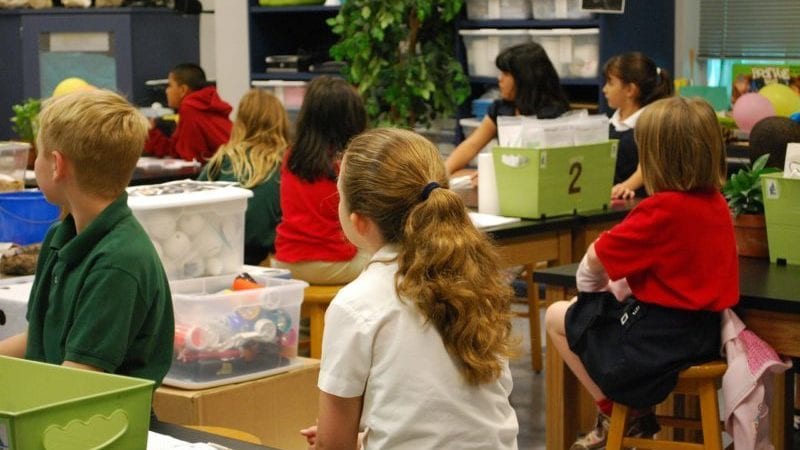
This quick series of physics experiments is perfect for introducing little learners to concepts of push and pull! In the experiments that follow, kids will investigate how they can change the speed and direction of objects by applying varying degrees of strength. It’s a great way to get young students excited about physics and STEM in general.
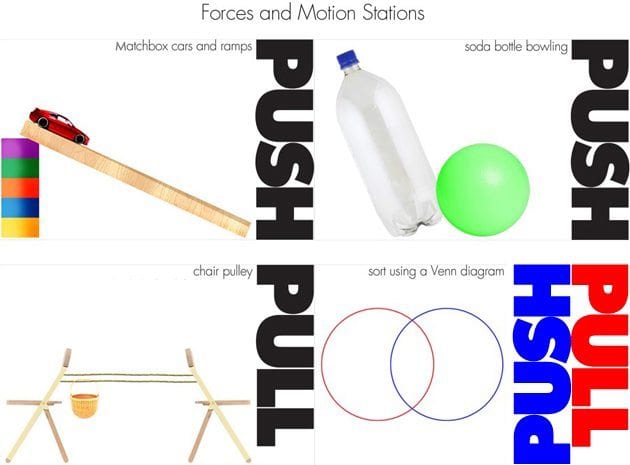
Step 1: Introduce the Physics Experiments
First, connect motion to what the children already know. Ask them, “How do we move?” Have children raise their hands and demonstrate. Next, drop a stuffed animal on the ground. Ask students, “How can I make the stuffed animal move?” They will think about their past experiences with moving objects to derive an answer. Then, explain that a push and a pull are both forces. Force makes an object move or stop moving. When we push something, we are moving it away from us. When we pull something, we are moving it closer to us. (Act out motions with students: push = palms out, push away from body, and pull = two fists on top of each other, pull toward body.)
Brainstorm : Create a t-chart, write down objects that can be pushed or pulled (objects at home, in the classroom, on the playground).
Step 2: Do Small-Group Instruction (Stations):
PHYSICS EXPERIMENT #1: SODA BOTTLE BOWLING
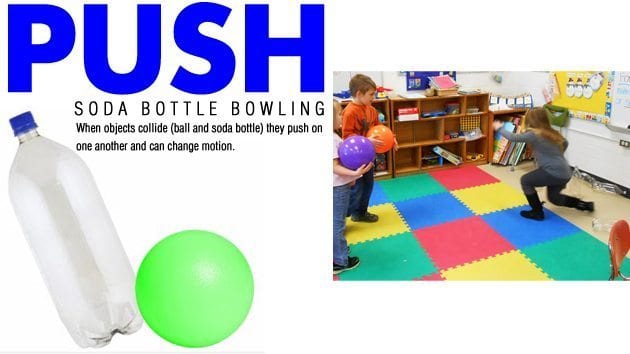
Push: Children experiment with pushing a ball hard and with less force to knock over soda bottles. They can compare a big push to a small push. What kind of push made the ball move the fastest? They will see how when objects collide (ball and soda bottle), they push on one another and can change motion. ADVERTISEMENT
PHYSICS EXPERIMENT #2: CHAIR PULLEY
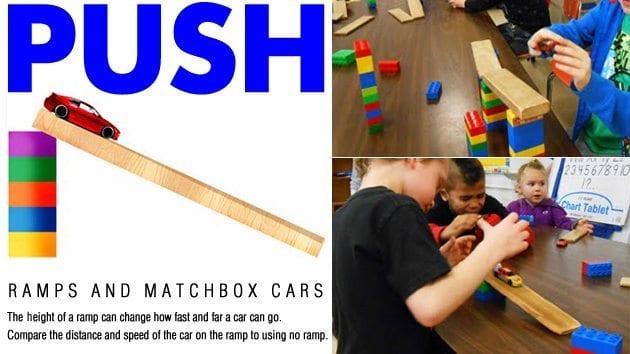
PHYSICS EXPERIMENT #3: RAMPS AND MATCHBOX CARS
Push: Children create ramps using flat, rectangular wooden blocks and Duplo Lego bricks. They will investigate how the height of a ramp can change how fast and far their Matchbox car can go. They will also compare the distance and speed of the car on the ramp to using no ramp.
PHYSICS EXPERIMENT #4: SORTING PUSH AND PULL
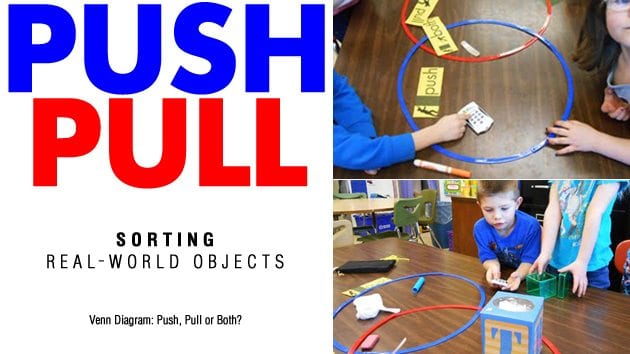
Sort: Put out a paper bag that contains various real-world objects. Children collaborate and sort the objects using a Venn diagram (hula hoops). Children place the objects in the appropriate groups using this free printable” push, pull or both .
Step 3: Reinforce the Concepts
After the physics experiments, children can play computer games to reinforce push and pull! I like these two:
- Push: Piggy Push from Cool Math Games
- Pull: Hook the Fish from Cookie
Or you can watch a video to reinforce pushes and pulls. For further reinforcement, the next day, have children go on a scavenger hunt and try to find things around the classroom that they can push and pull.
Step 4: Assessment
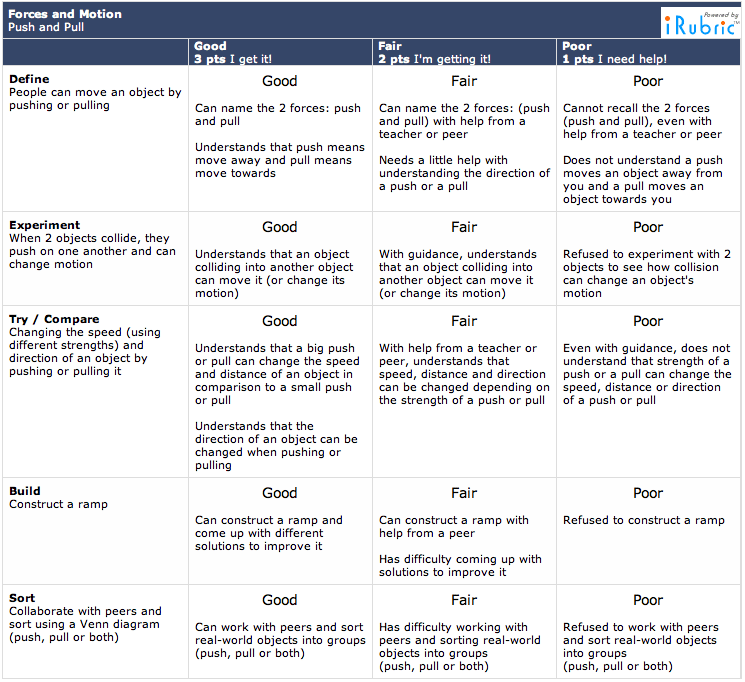
Children are assessed through observation, questions, and conversations while they work in small groups at stations, interacting with various objects that demonstrate pushing or pulling. I took notes and scored the children using a rubric I made in iRubric. You can download it for free!
You Might Also Like
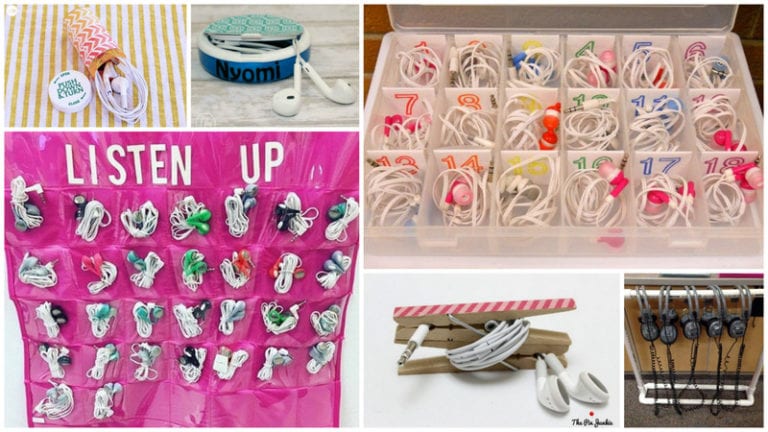
15 Headphone and Earbud Storage Solutions That Really Work
Say goodbye to tangled cords! Continue Reading
Copyright © 2024. All rights reserved. 5335 Gate Parkway, Jacksonville, FL 32256
- Skip to primary navigation
- Skip to main content
- Skip to primary sidebar
Teaching Expertise
- Classroom Ideas
- Teacher’s Life
- Deals & Shopping
- Privacy Policy
How Do Things Move? 30 Push And Pull Activities For Kindergarten
November 13, 2023 // by Louise Pieterse
Teaching kindergarteners about Newton’s laws might seem a little excessive but there are tons of craft and interesting ways you can start to expose them to the conceptions of forces and motion. These creative activities will get them to notice how forces are at play in their everyday lives and how a simple push or pull can have an impact on an object. Expose young ones to basic principles of science and help them foster a love for physics with these fun push and pull activities perfect for the classroom or at home.
1. Marble Maze

Kids and marbles are a match made in heaven, so why not introduce a fun marble game into their push and pull lesson plan. Let them create a simple marble maze with a paper place and some scrap paper and help them to see how their actions will affect the movement of the marble.
Learn More: Sowing Seeds Librarian
2. Gross Motor Activity for Push and Pull
Push and Pull forces are best explained with a few gross motor activities where kids can use their whole bodies to feel the effects. An oven tray, laundry basket, and a wagon will show kids how friction works and how both pushing and pulling have different effects on each item.
Learn More: Paper and Glue
3. Wind Force Activity

Not only should kids learn about the concepts of push and pull, but they should also be learning examples of these motions and how they can affect the movement of objects. Some pom-poms and straws quickly turn into a race, showing kids how wind can move these objects around.
Learn More: Love Those Kinders
4. Magnet Powered Car
Forces and motion are easily demonstrated with magnets. Tape a magnet to a toy car and let kids race the cars along a track to see when they can use the magnet to push and when to pull. Kindergarten students simply love the interactive nature of this lesson and will be begging for just one more round on the track.
Learn More: Science Kiddo
5. Cut and Paste Activity
A free printable activity sheet is a fun way to introduce kids to the basics of forces. The illustrations show relatable situations where these forces are applied and kids can quickly sort them into two easy-to-understand columns.
Learn More: The Kindergarten Connection
6. Read a Book about Forces
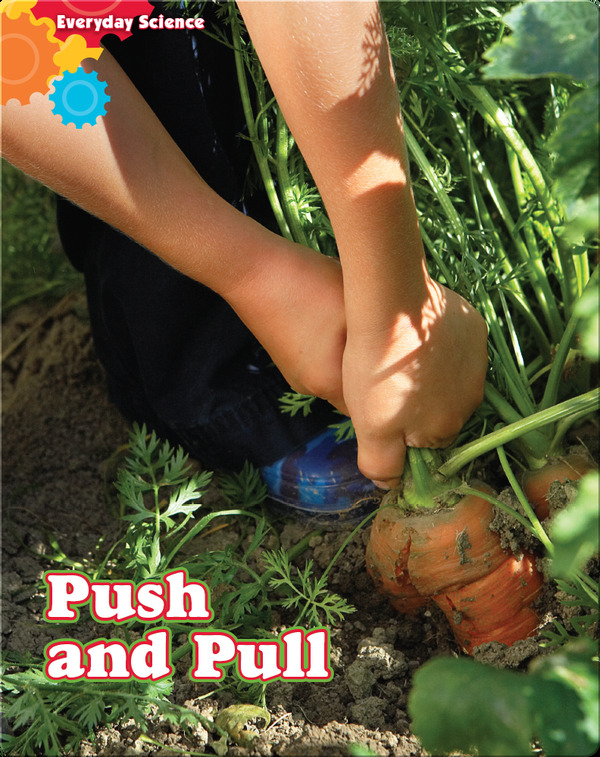
It is always a good idea to introduce new concepts during storytime, especially if the reader has fun and colorful images like this one. Enjoy free online reading resources for a variety of push and pull related stories.
Learn More: Get Epic
7. Row Your Boat Motion Activity
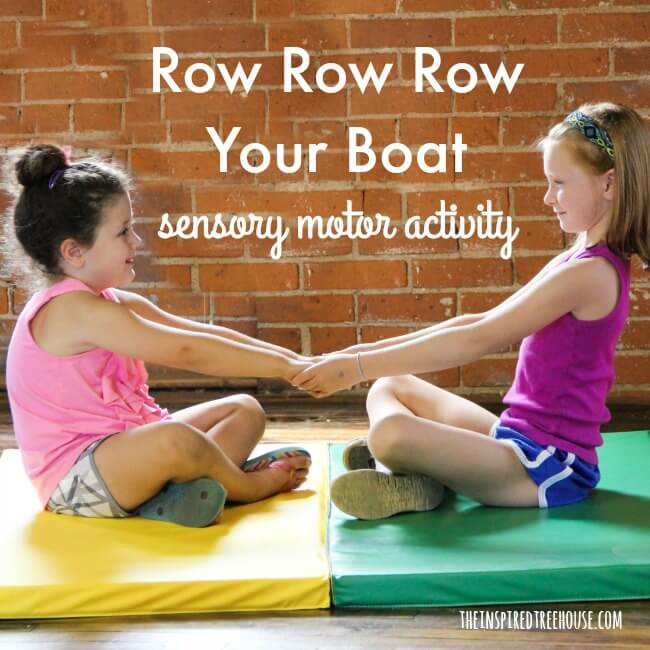
means of song or games is a fool-proof way to grab their attention. This simple back-and-forth motion game is done along with the ever-popular song “Row, Row, Row Your Boat”.
Learn More: The Inspired Treehouse
8. Push and Pull Venn Diagram
Once kids know the difference between push and pull, let them complete a simple Venn diagram to see if they can differentiate between the two and also identify which action uses both motions.
Learn More: Mrs. Wood’s Kindergarten Class
9. Watch a Youtube Video
This fun and interactive video lets kids see the difference between these two forces and introduces learners to concepts that might otherwise be slightly tedious to learn.
Learn More: Kids Academy
10. Make a Pocket Notebook
This fun science notebook includes a variety of activities where kids can color pictures of objects that move as a result of push and pull forces. There are plenty of pictures to cut out and paste in their own notebooks which they can use throughout your motion lessons as reference.
Learn More: The Barefoot Teacher
11. Tug of War
One of the most basic yet effective push and pull activities is a classic game of tug of war. Take a moment before and after the game to let kids observe the rope in its static position and how force had an effect on the rope and on each other.
Learn More: Ravenox
12. Put Balls in Motion
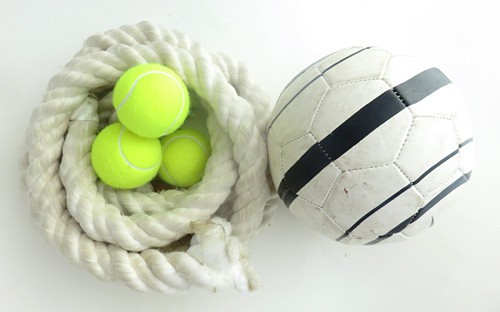
Kids play with balls all the time without thinking about what forces are at play. Use tennis balls or soccer balls to let kids figure out if they are using a push or pull force and how stopping the ball or interfering in the movement will affect the motion and direction.
Learn More: Science Buddies
13. Racing Ramps
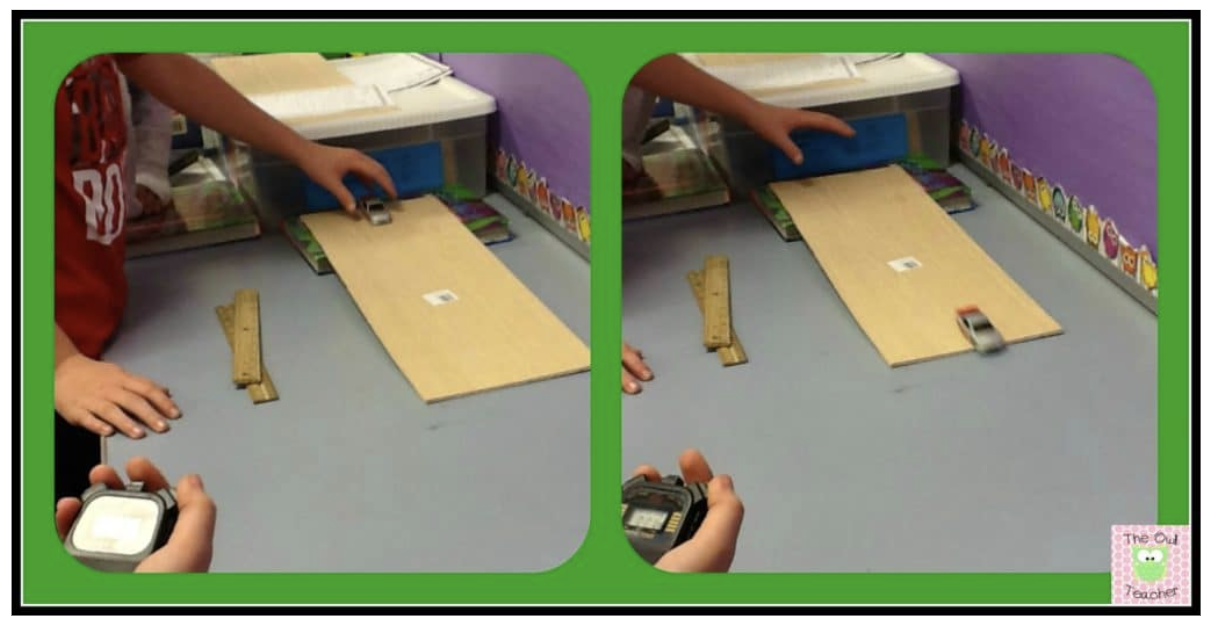
Racing cars is always a hit with kindergarteners and they rarely realize this fun activity is also a major lesson about the forces of motion. Kids should take note of the impact on the car if it is pushed from a ramp or if the ramp’s incline is changed.
Learn More: The Owl Teacher
14. Bottle Bowling

A lesson on motion during science time can also include a fun game of bowling. Kids can see how the ball will move faster or slower depending on how hard they push and how the ball will push over the bottles.
Learn More: Crafts for Kids
15. Magnetic Maze
Magnets easily demonstrate the concept of “pull” so why not create a fun game out of it? Let kids draw a maze on a paper plate and then use a magnet on either side of the plate to navigate through it. They can make the maze themed to their liking, adding another element of fun.
Learn More: Skip to my Lou
16. Go the Distance
This fun 3-part worksheet will let kids measure the distance their car goes depending on the force they apply. Seeing their measurements in numbers will give them a good indication of the forces at play.
Learn More: Mrs. B’s Beehive
17. Yo-Yo Games
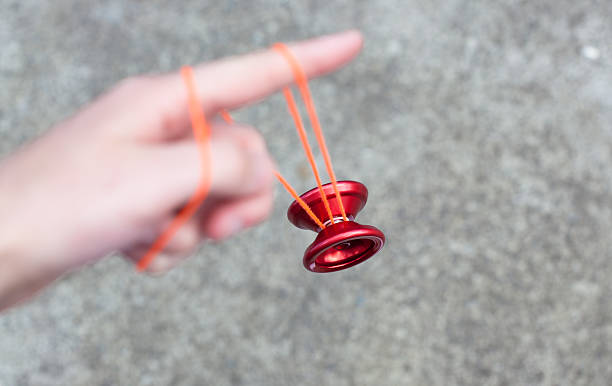
Doing tricks with yo-yos is a lost art that you can bring back to life as a push and pull lesson. Show students how to use this fun toy and let them explore this basic action on their own. Explain how the forces of push and pull affect the yo-yo’s motion.
Learn More: Let’s Talk Science
18. Bottle Rockets
What goes up, must come down! That is the law of gravity, a major “pulling” force that kids will learn about in kindergarten. Launch bottle rockets to show students how they are “pushed” up into the air and “pulled” back to earth.
Learn More: Science Sparks
19. Egg Drop Experiment
Doing a classic egg drop parachute experiment is always fun for young learners, but it is also a great opportunity to show the pulling effects of gravity and the pushing effects of air.
Learn More: The Gazette
20. Force and Motion Little Readers
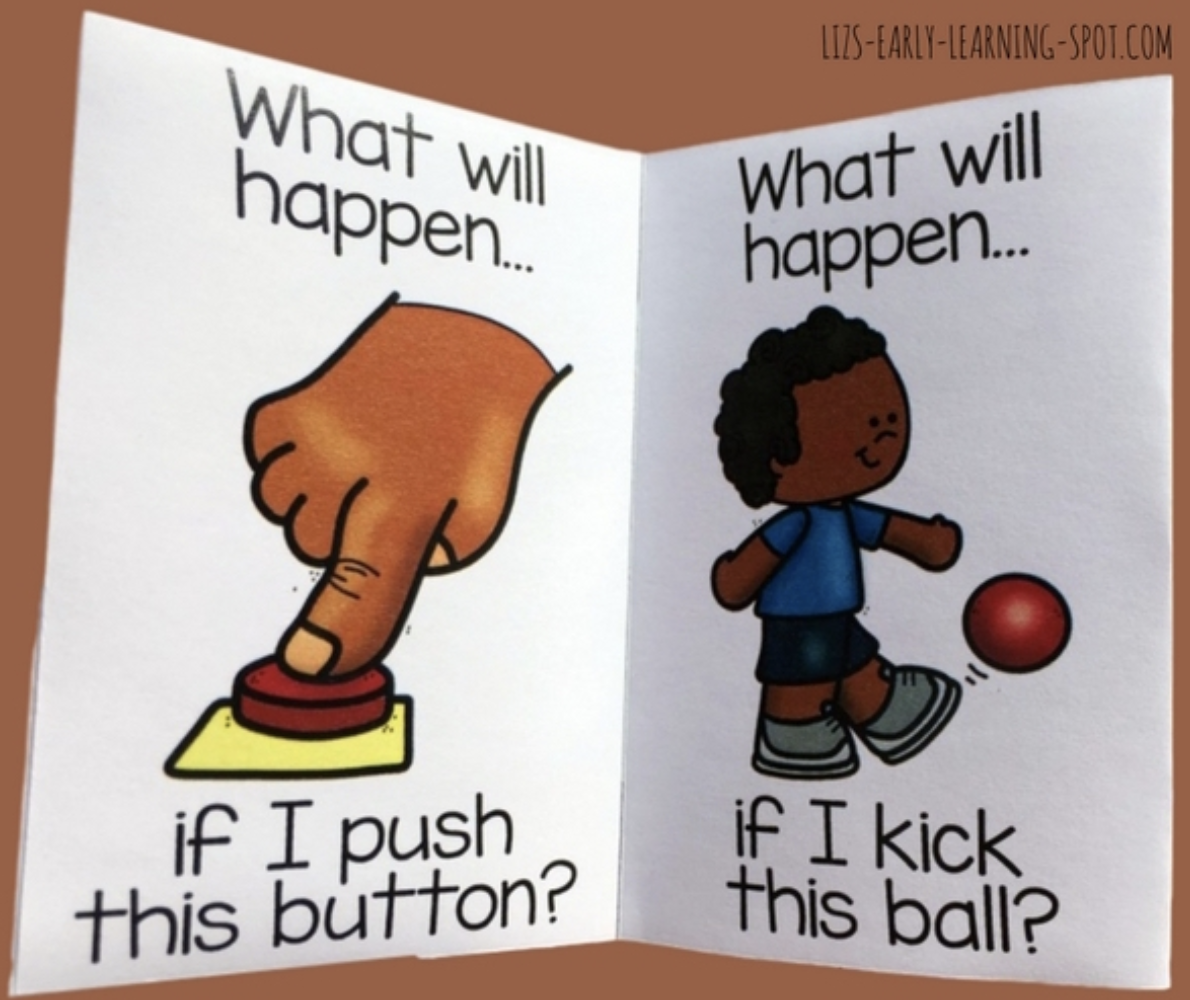
These fun personal readers will show kids the causality involved with push and pull motions. It is free to download and kids can color in the creative illustrations to make their own readers.
Learn More: Liz’s Early Learning Spot
21. Pumpkin Roll
To make your push and pull fall-themed, add a pumpkin into the mix for some extra fun. You should also use pumpkins of different sizes and weights to show kids how weight can influence the concepts of push and pull.
Learn More: Little Bins for Little Hands
22. Pom Pom Poppers
Be warned, anarchy is sure to ensue as kids pop their pom-poms across the classroom but you can rest assured that they are learning while having fun. These poppers show how the pull of the balloon then pushes the pom poms out of the “canon” in an equal and opposite reaction.
Learn More: Learn With MnM
23. Paper Airplane Race
Creating paper airplanes is an excellent activity to develop fine motor skills as little hands try to cut and fold on the lines. But flying these planes is also a great way to illustrate push and pull forces as they launch the planes and it is pulled to the ground by gravity.
Learn More: Halley Buzz
24. Magnetic Art
Magnetism explores the concepts of push and pull and can be introduced in tons of creative ways. Creating art with magnetic objects is a fantastic 2-in-1 activity where kids get to combine art and science in one colorful activity.
Learn More: Children’s Art Centre
25. Balloon Rockets
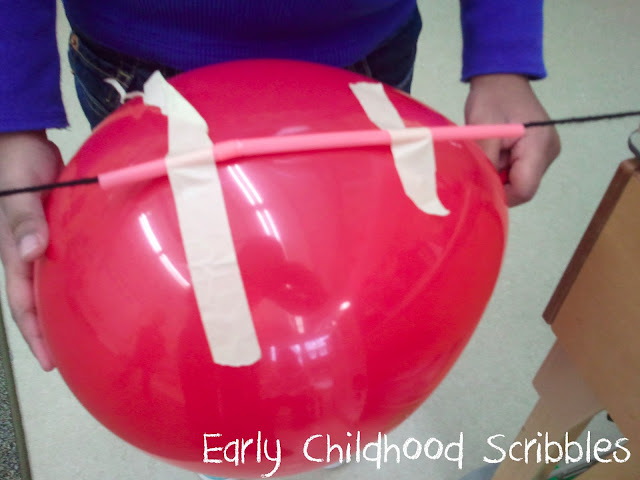
This fun activity only requires a few basic materials that you have lying around the classroom and offers tons of fun as kids try to race their balloons. Let kids see how balloons of different sizes race across the track or how balloons that have been weighed down are slower.
Learn More: Early Childhood Scribbles
26. Wrecking Ball
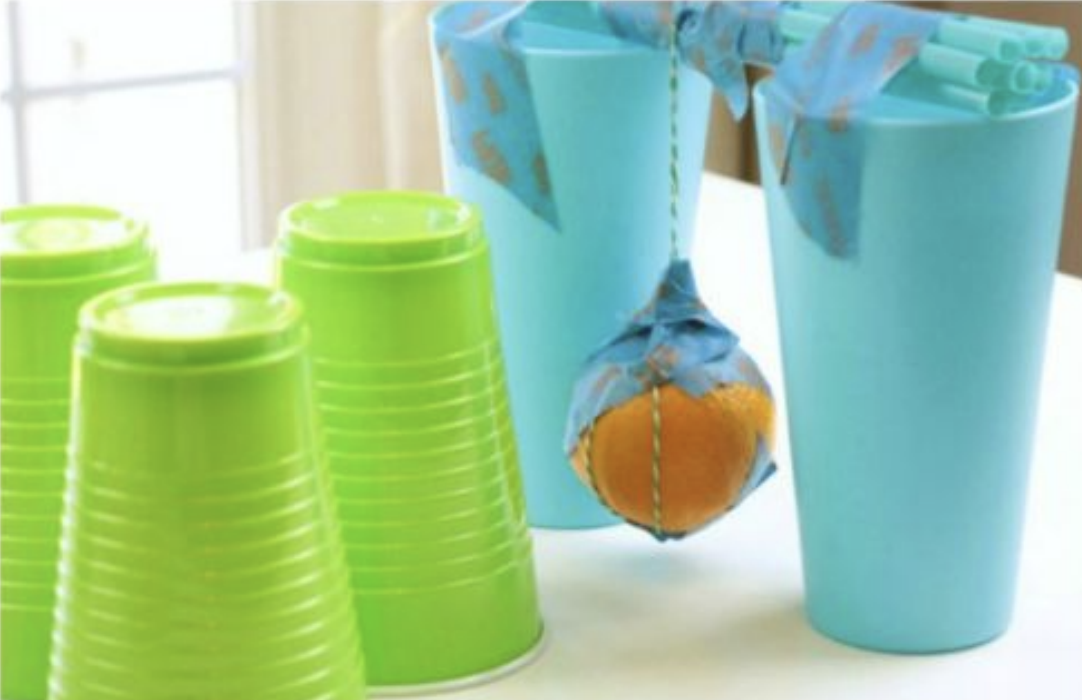
With only a few simple supplies you can build a destructive wrecking ball that knocks down everything from empty cups to a stack of blocks. Try to use different items for the wrecking ball and see which one knocks down the most in its swing of destruction.
Learn More: San Diego STEM Ecosytem
27. Make a Catapult
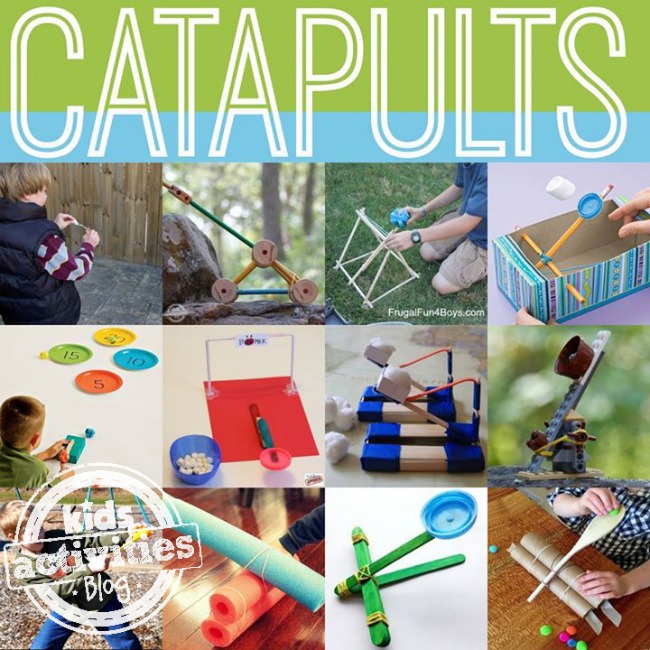
Catapults are a fun way to demonstrate how a pul in one direction will cause a push in the opposite direction. Kids should also observe how the power put into a pull affects the force of the push. Add snacks in your catapult for a yummy treat after the lesson.
Learn More: Kids Activity Blog
28. Whirlygig

If you are looking for a creative addition to a push and pull lesson, try this fun whirlygig craft. Kids will love watching the colorful patterns dance but also learn what happens when they pull on the string and how the string is pushed in the opposite direction.
Learn More: The Craft Train
29. Push and Pull Bingo
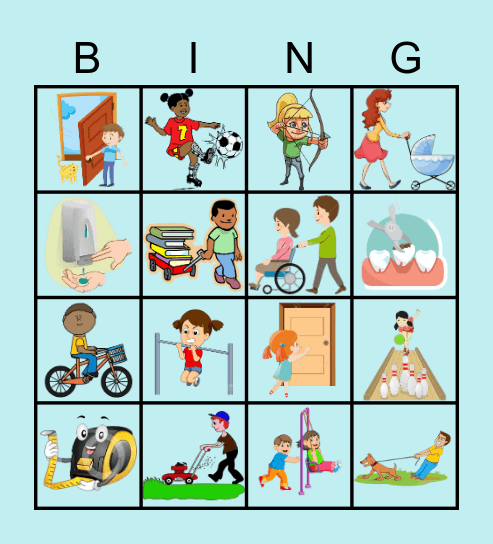
Kids never seem to tire of a good old-fashioned game of bingo. This set of bingo cards is filled with various push and pull activities that kids should be able to identify as one or the other.
Learn More: Bingo Baker
30. Stack Some Dominoes

Watching dominoes tumble is a guaranteed way to have kids jumping with joy. Pack out elaborate patterns and show kids how one little push can have big effects down the line.
Learn More: Playdough to Plato


All About Force: Push and Pull

Please enable JavaScript
It can also warm them up. Try rubbing your hands together. Are your hands warmer? Gravity is a natural force. It pulls everything down towards the earth .

Push and Pull Facts for Kids
Basic physics concepts, force and motion, simple machines (levers, pulleys), magnets and magnetism, science experiments for kids, gravity and its effects, friction and its role, physical education and sports, the concept of opposites, playground games and activities, fun facts about forces for kids, what is force for kids, force vocabulary, learn more all about force: push and pull.
A video excerpt of the forces, push and pull.
Forces Q&A
Push and Pull
Law of motion #2: The speed at which an object moves depends upon the amount of force used to move the object. The weight of an object also determines how it responds to the force being used to move it.
Testing Newton’s laws
Let’s try a few things to see how the laws of motion work.
Here is what you need:
Here is what you do:, what happened:.

- Sign in / Register
- Administration
- Edit profile

The PhET website does not support your browser. We recommend using the latest version of Chrome, Firefox, Safari, or Edge.
Share a free trial
Thanks for sharing, how can we help you, science units, kindergarten, open-and-go lessons that inspire kids to love science., science curriculum for k—5 th grades..
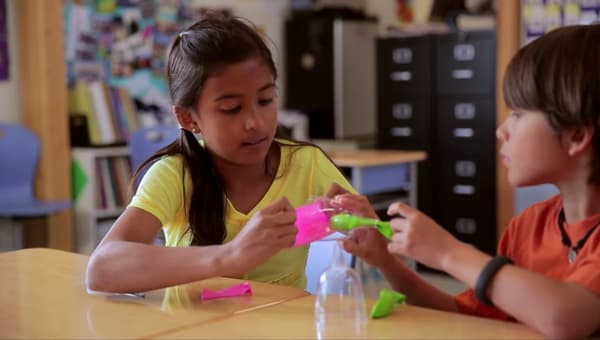
- Hands-on — lead students in the doing of science and engineering.
- Standards-aligned science lessons — Cover core standards in 1-2 hours of science per week.
- Less prep, more learning — prep in minutes not hours. Captivate your students with short videos and discussion questions.
Sign up now to try Mystery Science for free .
Sign up now for a free trial through June 30, 2025. Get tons of lessons!

Science Units
- Animal Needs
- Plant Needs
- Severe Weather
- Weather Patterns
- Sunlight & Warmth
Pushes & Pulls

K What's the biggest excavator?
Lesson + Activity
Standards Aligned
Pushes, Pulls, & “Work Words”
K why do builders need so many big machines, motion, speed, & strength, k how can you knock down a wall made of concrete, speed & direction of force, k how can you knock down the most bowling pins, direction of motion & engineering, k how can we protect a mountain town from falling rocks, forces & engineering, k how could you invent a trap, about this unit.
In this unit, students are introduced to pushes and pulls and how those affect the motion of objects. Students observe and investigate the effects of what happens when the strength or direction of those pushes and pulls are changed.
Unit Resources
Standards alignment guide, pacing guide, pacing guides in google sheets.
Need Excel versions?
Pacing Guides in Excel
Note: We've optimized for Google Sheets as it's free for all users. Excel downloads may have formatting differences.
Need Google Drive versions?
Lesson 1 : Pushes & Pulls
Be a digging machine.
In this lesson, students discover that there are pushes and pulls involved in any kind of work, including the work done by machines. In the activity, Be a Digging Machine, students pretend to use shovels and excavators to dig a hole for a swimming pool.
This activity does not require supplies.
Make sure students have enough space to move around as they dig like a digging machine. No other preparation needed.
Read-Along Lesson 2 : Pushes, Pulls, & “Work Words”
Forces at work.
In this Read-Along lesson, Vivian watches a house being built and wonders why the builders need so many big machines. The lesson includes a short exercise where students act out the “work words” of their favorite machine. You can extend the lesson with the optional activity, Forces at Work, where students watch videos of construction equipment and practice using work words to describe what the machines are doing.
As an optional activity, we include videos of three construction machines, like the ones Vivian saw in the story. The videos include songs about the construction machines and what they do.
We suggest you preview the videos. When you show them to your students, you may want students to act out what the machines do. After watching the videos, ask your students to describe what each machine does and identify the "work words" involved.
Lesson 3 : Motion, Speed, & Strength
Don't crush that house.
In this lesson, students change the strength and direction of a wrecking ball’s push in order to solve a tricky problem. The activity, Don't Crush That House, is a game in which students experiment with the force of a paper wrecking ball in order to knock down a wall of cups. The challenge is: they can’t knock down the paper houses!
I have a Mystery Pack
| printout | Print 8 copies |
| 1 roll | |
| 8 sticks | |
| 16 clips | |
| 1 roll | |
| 24 cups | |
Your students will play the Wrecking Ball game in groups, taking turns. To help you determine how many game stations to set up, we suggest splitting your class into groups of 4.
Prepare Game Stations Before Class
Before class, get all the Game Station pieces ready for your students.
- Find the page titled “The Foldable Houses.” Cut out and fold the houses. (If you are making multiple stations, you can use a paper cutter.)
- Find “The Foldable Wrecking Ball” page. Fold it and tie it to the end of the ribbon, following the instructions printed on the sheet. Use transparent tape to keep the Wrecking Ball from unfolding.
- You are going to use masking tape to attach the yardstick to your support. To see how, watch this short video. For easier taping, clip the stick to the support first. Make sure the stick is at a 45º angle. Tape at two points — high & low.
- Adjust the length of the ribbon so that the wrecking ball will hit the top of the cups as it swings. Clip the ribbon in place with a binder clip.
- Tape the Game Board to the floor, like this. (Match A with A and B with B.)

Read-Along Lesson 4 : Speed & Direction of Force
Human bumper bowling.
In this Read-Along lesson, Daniel worries he won’t do well at a friend’s Bumper Bowling party…until he figures out an unexpected way to win. The lesson includes a short exercise where students act out bowling. If you want to extend the lesson, you can try this optional activity, Human Bumper Bowling, where students make a model bumper bowling alley and work together to knock down pins.
| 16 books | |
| 1 stick | |
| 200 feet | |
| 48 cups | |
| 8 balls |
We suggest having students work in groups of four to six.
This activity requires enough floor space to set up “bowling alleys.” Decide how many you’ll set up and where you’ll put them. Using masking tape, mark off alleys that are 10 feet long and 2½ feet wide. Mark a box at the end to set the pins in. Leave room between your bowling alleys for students to sit on the floor.

Lesson 5 : Direction of Motion & Engineering
Boulder bounce.
In this lesson, students investigate how pushes can change the speed and direction of falling objects. In the activity, Boulder Bounce, students play a game where they design a solution that protects a model town called Tiny Town from a bouncing-ball “boulder.”
| printout | Print 15 copies |
| 30 cups | |
| 15 feet | |
| 75 pins | |
We suggest students work in pairs. Homeschool students can work on their own.
We suggest one game station for every pair of students, but you can set up as many stations as you think might be practical for your classroom.
Set Up Game Stations Before Class

Make a “cardboard hill” by stacking 4 pieces of cardboard and clipping them together using a large binder clip. (If you are using a clipboard, stack two pieces of cardboard and insert under the clip of the clipboard.)
Make a 3-inch stack of books on a desk or table. Make a hill by setting the clipped end of your cardboard on the edge of the books.
Tape the bottom of the cardboard to the table with masking tape to keep the assembly from slipping.
Tape one cup to the top right corner of the cardboard. Be sure the lip of the cup sits ON TOP of the cardboard’s edge, and not below it.
Tape the other cup to the bottom left corner of the cardboard, so that it hangs off the edge of the clipboard and onto the table. Be sure the lip of the cup sits BELOW the edge of the cardboard, and not on top of it.
Cut out the Tiny Town houses, fold, and place them next to the cup at the bottom of the ramp. Stick the pushpins into the top left corner of the assembly, and the game station is ready to go.
Read-Along Lesson 6 : Forces & Engineering
Be an inventor.
In this Read-Along lesson, twins Mimi and Lulu try different ways to catch a mysterious nighttime visitor…until they hit on just the right solution. The lesson includes a short exercise where students imagine how to design a good monster trap, and then pretend to be sneaky monsters. You can extend the lesson with the optional activity, Be an Inventor, where students draw their own inventions for machines that do chores.
| 30 sheets | |
| 30 crayons |
As an optional activity, we suggest you have your students explore what it takes to be an inventor. Have them watch the mini-lesson "How do you become a great inventor?" to start them thinking about the inventions all around us.
Then each student will think about and act out a chore they do. You may have to remind them of possible chores, such as making their bed, feeding the cat, walking the dog, setting the table, or picking up their toys. After acting out a chore, students will think up a machine that could help with this chore and draw their machine. Finally, students will share their drawing with a partner and explain how their machine works.
This episode is locked
This lesson is not included in your limited access.
Invite 5 or more friends and we'll unlock all previous episodes as a thank you!

Why is the sky blue?

Why do we call them doughnuts?

Could a turtle live outside its shell?
No-spam Policy
Any emails you provide are only used to enable you to send an email to your friends. You will see a preview of the email and can edit it before sending. These people won’t be added to any lists, and at most they will receive one follow up email from our founder, Doug. They will never be spammed. For more information, check out our privacy policy .
Your membership is expired. The archive of past Mini Lessons is not included in your limited access.
- Chrome (recommended)
- Microsoft Edge

- Categories S.T.E.A.M. , Science
Push And Pull Activities
- Greg Smedley-Warren
- March 22, 2024
- No Comments

If you’re looking for push and pull activities, our Push And Pull Research Project is just what you need. This engaging science unit is full of interactive push-and-pull activities designed to help students understand force, motion, and push and pull.
A staple of our classroom curriculum is our TKS Research Projects. These projects effectively integrate research and writing into our ELA block while also integrating science and social studies. What sets our research projects apart is their incorporation of hands-on activities and art projects, which enriches the learning experience.
Push And Pull Activities: Push And Pull Research Project

To introduce movement and force, we start by dancing. I mean, that only seems natural?! Right?! We did the Hokey Pokey a few times, and after we “shook it all about,” we brainstormed as many different kinds of movements as we could come up with!

Our second activity started with a question: Can objects move by themselves? My kids created cars and trucks and used them to answer our questions. We then had a turn-and-talk discussion before sharing our thoughts. The turn-and-talk helped them fine-tune their ideas and build their confidence, making them more comfortable sharing!

After we voted I asked one student to move the chair. Then we discussed what happened. We quickly realized that objects cannot move by themselves. They need a force!! Then we got to be the force! Each student picked something in our classroom to move! After we moved the object, we decided if we pushed or pulled the object!

The students then drew a picture in their push and pull research journal showing them moving the object.

This allowed us to learn about two types of force: push and pull. And then we created our push and pull anchor chart!

We also created a push-and-pull sort to determine whether items could be pushed, pulled, or both!

Push And Pull Activities: The Great Laundry Basket Race
Once we understood push and pull, it was time to do some pushing and pulling! It was time for THE GREAT LAUNDRY BASKET RACE! The kids paired up and predicted how many seconds it would take them to push and pull their friends across the carpet! People, this was beyond EPIC! The laughter and learning that took place were everything that learning and science should be! Just check out the video!
We ended our push-and-pull research project with a Kindergarten Tug-Of-War championship! We competed with all 8 kindergarten classes to determine the push-and-pull champion, and yes, our class emerged the victors!

And if you win the tug of war championship and you’re learning about push and pull, you end the week with PUSH POPS!

All of our TKS RESEARCH PROJECTS are ALWAYS BUY 1 GET 1 50% OFF! USE THE CODE RPBOGO50. (Valid only in the TKS STORE! www.tksstore.com)

Check out our other research projects:
Push and pull activities freebie.

For more information, check out these posts:

Blog Categories
Related posts, kindergarten halloween activities.
Holidays in the classroom are fun, exhausting, and full of opportunities to learn about cultures, traditions, and customs. However, we also know that holidays in
Weekly Kindergarten Lesson Plans: Chicka Chicka Boom Boom, Math, Apples
Welcome to the birthday edition of Schedulin Sunday! Today is Mr. Greg’s birthday and it’s week 8 of kindergarten, and our kindergarten lessons and we
Kindergarten Comprehension Lessons: October Read Alouds
October is an exciting time in kindergarten and every grade. It’s also one of those months that is challenging to keep kids engaged. You know
Join Our Newsletter
Subscribe to get our latest content by email.
Success! Thank you for joining our newsletter. You will not receive a confirmation email.
There was an error submitting your subscription. Please try again.
join our newsletter!
Copyright ©2024 – All Rights Reserved by The Kindergarten Smorgasboard | Built and managed by EyeCandy Creative
- Skip to primary navigation
- Skip to main content
- Skip to primary sidebar

- FREE Experiments
- Kitchen Science
- Climate Change
- Egg Experiments
- Fairy Tale Science
- Edible Science
- Human Health
- Inspirational Women
- Forces and Motion
- Science Fair Projects
- STEM Challenges
- Science Sparks Books
- Contact Science Sparks
- Science Resources for Home and School
Push and Pull Play Dough Animals
February 22, 2024 By Emma Vanstone Leave a Comment
These simple play dough animals are great for a push and pull or forces topic.
The idea is that children create animals from play dough or other modelling material using push and pull forces.
You’ll need
Instructions.
Follow my simple instructions or create your own play dough animals using push and pull forces.
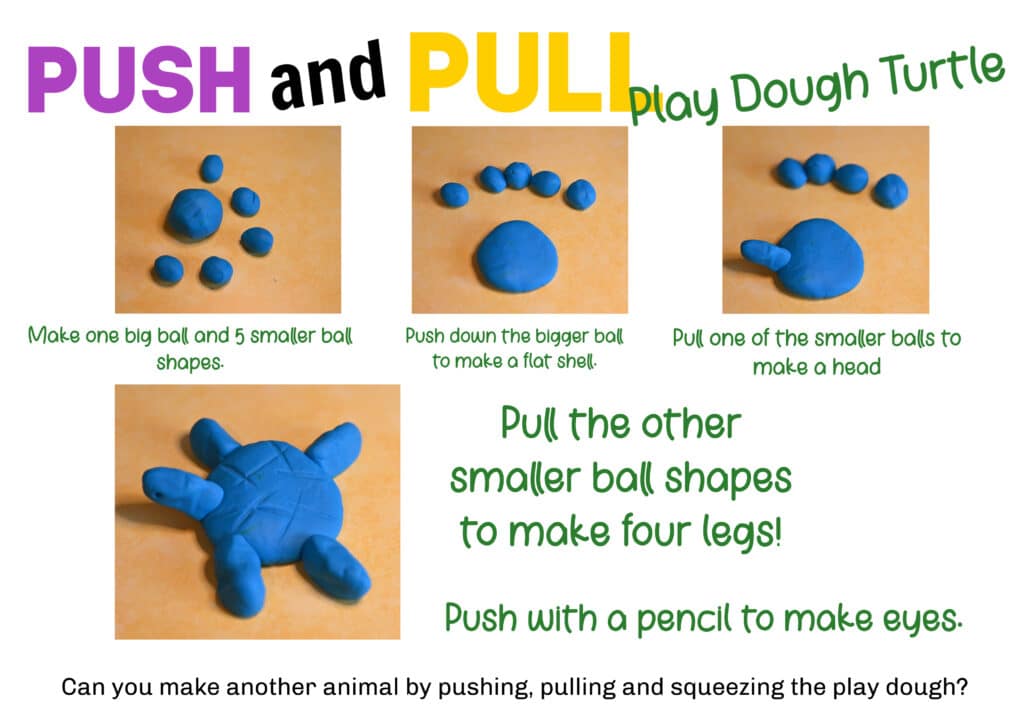
As an extension task, twists, squashes, and other movements can be added.
This activity encourages children to:
Learn that pushes and pulls are examples of forces.
Use and explore vocabulary such as – push, pull, bend, squash, twist
Manipulate materials
Work as a team
Science concepts
Push and pull forces
More science activities about forces
My push and pull puppets are another fun way to learn about push and pull forces .
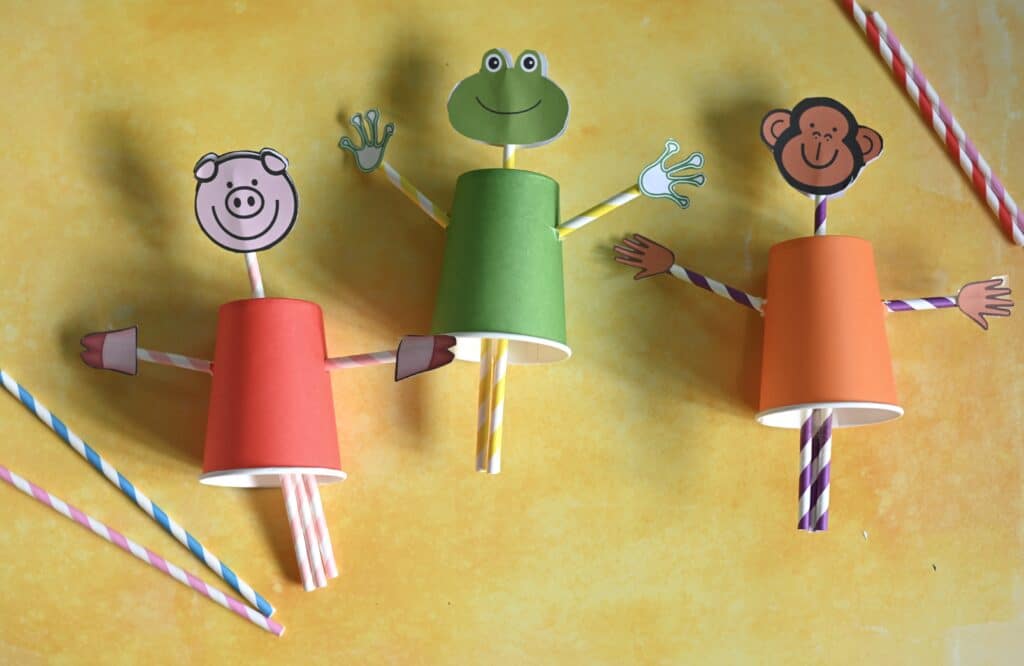
Make a push and pull venn diagram .
Learn about forces with a DIY stomp rocket .
Last Updated on February 22, 2024 by Emma Vanstone
Safety Notice
Science Sparks ( Wild Sparks Enterprises Ltd ) are not liable for the actions of activity of any person who uses the information in this resource or in any of the suggested further resources. Science Sparks assume no liability with regard to injuries or damage to property that may occur as a result of using the information and carrying out the practical activities contained in this resource or in any of the suggested further resources.
These activities are designed to be carried out by children working with a parent, guardian or other appropriate adult. The adult involved is fully responsible for ensuring that the activities are carried out safely.
Reader Interactions
Leave a reply cancel reply.
Your email address will not be published. Required fields are marked *
Sowing Seeds Librarian
Providing youth access to ideas through their school and public library, kids’ stem workshop: marble maze (push and pull physics).

The skinny: This was a super fun program, although it was one of our shortest ones yet. I talked with the kids for about 15 minutes giving them some background in forces, balance, and push and pull physics. Then, I turned the kids loose on building their own marble runs. It only took the kids 15 minutes to design their own, which was much less time than I expected. In the future, I will try to combine this with a second activity to stretch it out, because I do like these workshops to go for 45-60 minutes. It was budget friendly, with supplies left over for me to do this again during our summer reading program.
Inspiration: I found this idea on Buggy and Buddy Blog . Her photos were so engaging that I thought, “We can try that!”
Cost: About $0.25 per child. I ordered a large box of Wikki Stix from Amazon for $23 (this box should serve 156 children, so we will certainly be doing this project again to go through it all!). I also ordered a large bag of Soak-Proof Foam Dinner plates ($4) so that the kids would have something sturdy to build on, and these plates had high edges. I also purchased three packs of 50 marbles for $1 at the Dollar Tree. We also used tape and scraps of construction paper that we had on hand. Each child received one plate, one marble, three of the Wikki Stix, and free access to the paper, markers, scissors, and tape.
Materials: Foam Plates Scissors Scrap construction paper Wikki Stix Tape Markers Marbles

Set up: To keep the kids on track (and not using more supplies than they needed) I took the time to prepare individual bags and place settings for each child. That way we did not have to fight about which color or Wikki Stix each child wanted. In each bag I placed 3 of the Wikki Stix, all in different colors and 1 marble. I set up the tables so that each table had five plates with the prepared bags, and I also pre-cut a piece of blue painter’s tape about 8 inches long and stuck it to the table. That way, each child has the materials they needed. I also pre-cut about 200 strips of paper approximately 1″ by 4″ to use for building arches and guards for their marbles. The paper strips were placed on the tables in pie tins so that the kids could grab them and use them at will.

Resources: I used the book, Give it a Push! Give it a Pull! A Look at Forces by Jennifer Boothroyd.
How it went : I brought all the kids and families into our Storytime/Programming Room. The kids sat on our magic carpet and I started off by placing a toy bus on the table. I asked the kids what the bus was doing. (Correct answer: nothing!) I then gave the bus a push. Now what is it doing? (Moving!) Why? One girl answered, “Because of the wheels!”) Really? I turned the bus on its side and gave it another push which sent it a few feet away. We got to the part that it was moving because I pushed it. I then pulled the bus over to me, and the kids go that it moved because I pulled it. Push=move something away from the force. Pull=moves something closer to the force.

After finishing the book, I showed the kids the marble run that I had created, and how they would be tilting the plate to push and pull and marble towards them, or away from them, for the marble to go through its maze. I had the kids count and time me to see how long it would take me for my marble to go through the maze that I had created. (Answer: 6 seconds!)

With the tables in place, the kids were ready to build! Like I said above, it only took them about 15 mintues to finished their maze. Then, the kids raced each other to see who could make their marble go through the maze fastest. I am getting smarter at this, and after the program I asked the kids to give me back and sandwich bag that held their marble and three Wikki Stix. I can re-use the bag, which cuts down on waste and cost! Some kids wanted to keep their bag, though, so their marble did not get lost on the way home, which was fine.
Another STEM Workshop in the books! Stay tuned for our February Workshops: Human Heart Science and Write Your Name in Computer Code!


IMAGES
VIDEO
COMMENTS
Immerse your primary students in the exhilarating world of Push and Pull Forces with our hands-on science experiments. Discover friction, wind power, and more through engaging activities like tea bag rockets, pom pom poppers, and paper airplanes. Foster curiosity and critical thinking with our detailed guides, POE model sheets, and bonus homework activities.
After the physics experiments, children can play computer games to reinforce push and pull! I like these two: Push: Piggy Push from Cool Math Games; Pull: Hook the Fish from Cookie; Or you can watch a video to reinforce pushes and pulls. For further reinforcement, the next day, have children go on a scavenger hunt and try to find things around ...
23. Paper Airplane Race. Creating paper airplanes is an excellent activity to develop fine motor skills as little hands try to cut and fold on the lines. But flying these planes is also a great way to illustrate push and pull forces as they launch the planes and it is pulled to the ground by gravity.
Other examples of forces are magnetism, gravity and air pressure. Over the years we've completed lots of forces experiments on Science Sparks, here are the best ones. Learn about simple push and pull forces in this easy activity. Friction Experiments for Kids What is Friction? Friction tries to stop objects sliding past each other.
Push and pull are types of forces. Push moves things away, pull brings them closer. You push a swing to make it move. You pull a door to open it. Gravity pulls objects toward the earth. Magnets can push or pull each other. Friction can slow a push or pull. A tug of war game involves pulling.
Get stuck into a science experiment with science author Debbie Roberts, who shows you how to teach Push and Pull forces in an enquiry-based format.#TakingSci...
In this video, we discuss the 2 different types of forces: push and pull motions. We explain the difference between the two forces, and provide real life exa...
Push and Pull. Newton's Laws of Motion tell us three things about how and why things move. Law of motion #1: An object will remain at rest until an outside force puts it in motion. Force is the push or pulls that starts something moving. Law of motion #2: The speed at which an object moves depends upon the amount of force used to move the object.
Scientists refer to a push or pull as a force. Forces can change the movement of objects (the object's speed and direction), but they do not always do so. Imagine a grocery cart standing still. ... Tell the students they will use balls for their experiment. Divide the class into small groups of 2 to 3 students. Have them sit across from each ...
Push a supermarket trolley. Push a swing. Push a bell. Pull Forces. A dog pulling on a lead. Pull down a zip. Pull a cracker. Push and Pull Forces. Hockey - push or pull the ball. Push or pull open a door. If you're starting a push and pull forces topic, you might like my push and pull puppets! Don't forget to take a look at my full ...
More ideas for learning about push and pull forces. Straw rockets are a great demonstration of a push force making an object move. You blow down the straw, and the force of the air makes the rocket fly. A stomp rocket is another example of a push force. Create a venn diagram of push and pull forces. Last Updated on February 19, 2024 by Emma ...
Create an applied force and see how it makes objects move. Change friction and see how it affects the motion of objects. Explore the forces at work when pulling against a cart, and pushing a refrigerator, crate, or person. Create an applied force and see how it makes objects move. Change friction and see how it affects the motion of objects.
Reflect (4 minutes) This video summarizes for students everything they have discovered about how pulls and pushes create motion. It also shows them real world examples of pushes and pulls, including how natural forces, like wind, can create pushes and pulls that move objects such as kites, sailboats, and wind turbines.
Learn how to move objects with push and pull forces in this fun video for kids. Join Homeschool Pop and discover the science of motion.
In this lesson, students change the strength and direction of a wrecking ball's push in order to solve a tricky problem. The activity, Don't Crush That House, is a game in which students experiment with the force of a paper wrecking ball in order to knock down a wall of cups. The challenge is: they can't knock down the paper houses!
Participate in guided investigations, including making observations using the senses, to explore and answer questions (VCSIS051) Compare observations and predictions with those of others (VCSIS054) Children investigate Push and Pull forces and Motion through plenty of hands-on activities and experiments in this fun science incursion.
Push And Pull Activities. If you're looking for push and pull activities, our Push And Pull Research Project is just what you need. This engaging science unit is full of interactive push-and-pull activities designed to help students understand force, motion, and push and pull. A staple of our classroom curriculum is our TKS Research Projects.
These activities are designed to be carried out by children working with a parent, guardian or other appropriate adult. The adult involved is fully responsible for ensuring that the activities are carried out safely. These simple play dough animals are great for a push and pull or forces topic. The idea is that children create animals from play ...
Kids' STEM Workshop: Marble Maze (Push and Pull Physics!) Put kids and marbles together and you automatically have a great time planned. Add a few lessons about Push and Pull, and you have an experiment in physics that combines fine motor skills, creative design, an understanding of force, and lots of marbles that went home with happy ...
A push or a pull affects how an object moves or changes shape (AC9S1U03). You could use this push and pull board game as a fun way to end any physics lesson with your Year 1 pupils. Your children have to identify the objects that you either push or pull. For example, a tube of toothpaste or a hairbrush.
Forces push and pull experiment for kidsExperiment time. ForcesPush and pullForces Changes in motion all have one thing in common. they require a FORCE, whic...
Push and Pull Experiments and ResourcesFun and HIGHLY engaging experiments for any push and pull, physical sciences and motion unit. The 8x experiments and 1x homework activity included encourage students to think about the forces involved in everyday motion. Concepts included on a basic level are - forces, push, pull, gravity, friction and ...